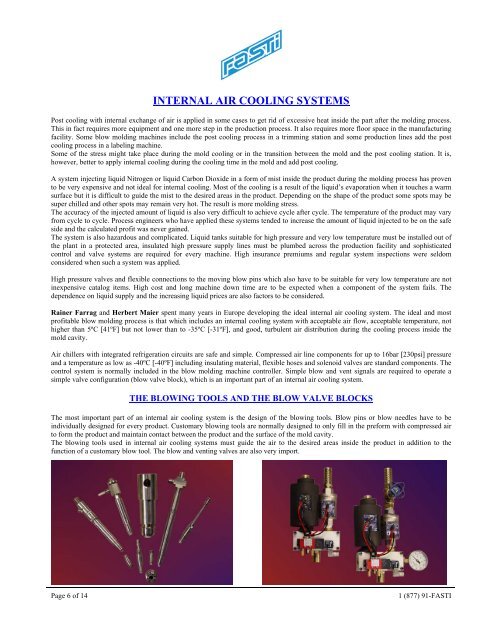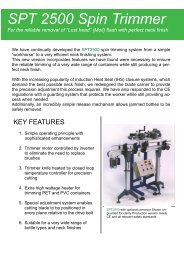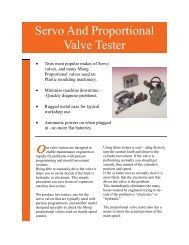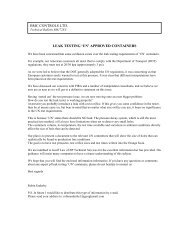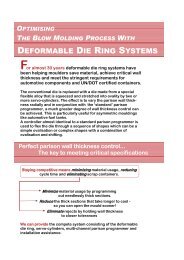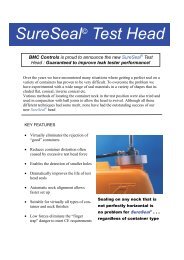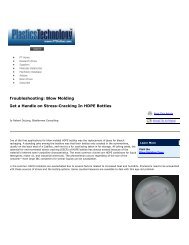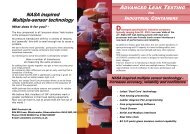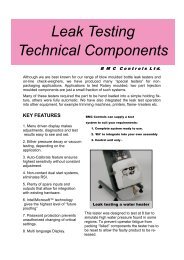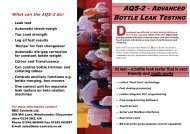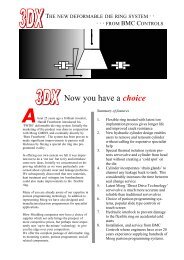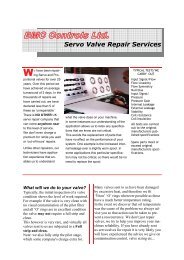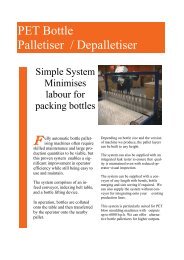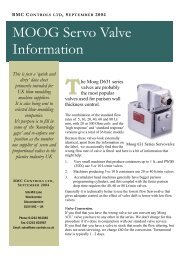internal cooling for the blow molding industry - Blow Moulding Controls
internal cooling for the blow molding industry - Blow Moulding Controls
internal cooling for the blow molding industry - Blow Moulding Controls
You also want an ePaper? Increase the reach of your titles
YUMPU automatically turns print PDFs into web optimized ePapers that Google loves.
INTERNAL AIR COOLING SYSTEMS<br />
Post <strong>cooling</strong> with <strong>internal</strong> exchange of air is applied in some cases to get rid of excessive heat inside <strong>the</strong> part after <strong>the</strong> <strong>molding</strong> process.<br />
This in fact requires more equipment and one more step in <strong>the</strong> production process. It also requires more floor space in <strong>the</strong> manufacturing<br />
facility. Some <strong>blow</strong> <strong>molding</strong> machines include <strong>the</strong> post <strong>cooling</strong> process in a trimming station and some production lines add <strong>the</strong> post<br />
<strong>cooling</strong> process in a labeling machine.<br />
Some of <strong>the</strong> stress might take place during <strong>the</strong> mold <strong>cooling</strong> or in <strong>the</strong> transition between <strong>the</strong> mold and <strong>the</strong> post <strong>cooling</strong> station. It is,<br />
however, better to apply <strong>internal</strong> <strong>cooling</strong> during <strong>the</strong> <strong>cooling</strong> time in <strong>the</strong> mold and add post <strong>cooling</strong>.<br />
A system injecting liquid Nitrogen or liquid Carbon Dioxide in a <strong>for</strong>m of mist inside <strong>the</strong> product during <strong>the</strong> <strong>molding</strong> process has proven<br />
to be very expensive and not ideal <strong>for</strong> <strong>internal</strong> <strong>cooling</strong>. Most of <strong>the</strong> <strong>cooling</strong> is a result of <strong>the</strong> liquid’s evaporation when it touches a warm<br />
surface but it is difficult to guide <strong>the</strong> mist to <strong>the</strong> desired areas in <strong>the</strong> product. Depending on <strong>the</strong> shape of <strong>the</strong> product some spots may be<br />
super chilled and o<strong>the</strong>r spots may remain very hot. The result is more <strong>molding</strong> stress.<br />
The accuracy of <strong>the</strong> injected amount of liquid is also very difficult to achieve cycle after cycle. The temperature of <strong>the</strong> product may vary<br />
from cycle to cycle. Process engineers who have applied <strong>the</strong>se systems tended to increase <strong>the</strong> amount of liquid injected to be on <strong>the</strong> safe<br />
side and <strong>the</strong> calculated profit was never gained.<br />
The system is also hazardous and complicated. Liquid tanks suitable <strong>for</strong> high pressure and very low temperature must be installed out of<br />
<strong>the</strong> plant in a protected area, insulated high pressure supply lines must be plumbed across <strong>the</strong> production facility and sophisticated<br />
control and valve systems are required <strong>for</strong> every machine. High insurance premiums and regular system inspections were seldom<br />
considered when such a system was applied.<br />
High pressure valves and flexible connections to <strong>the</strong> moving <strong>blow</strong> pins which also have to be suitable <strong>for</strong> very low temperature are not<br />
inexpensive catalog items. High cost and long machine down time are to be expected when a component of <strong>the</strong> system fails. The<br />
dependence on liquid supply and <strong>the</strong> increasing liquid prices are also factors to be considered.<br />
Rainer Farrag and Herbert Maier spent many years in Europe developing <strong>the</strong> ideal <strong>internal</strong> air <strong>cooling</strong> system. The ideal and most<br />
profitable <strong>blow</strong> <strong>molding</strong> process is that which includes an <strong>internal</strong> <strong>cooling</strong> system with acceptable air flow, acceptable temperature, not<br />
higher than 5ºC [41ºF] but not lower than to -35ºC [-31ºF], and good, turbulent air distribution during <strong>the</strong> <strong>cooling</strong> process inside <strong>the</strong><br />
mold cavity.<br />
Air chillers with integrated refrigeration circuits are safe and simple. Compressed air line components <strong>for</strong> up to 16bar [230psi] pressure<br />
and a temperature as low as -40ºC [-40ºF] including insulating material, flexible hoses and solenoid valves are standard components. The<br />
control system is normally included in <strong>the</strong> <strong>blow</strong> <strong>molding</strong> machine controller. Simple <strong>blow</strong> and vent signals are required to operate a<br />
simple valve configuration (<strong>blow</strong> valve block), which is an important part of an <strong>internal</strong> air <strong>cooling</strong> system.<br />
THE BLOWING TOOLS AND THE BLOW VALVE BLOCKS<br />
The most important part of an <strong>internal</strong> air <strong>cooling</strong> system is <strong>the</strong> design of <strong>the</strong> <strong>blow</strong>ing tools. <strong>Blow</strong> pins or <strong>blow</strong> needles have to be<br />
individually designed <strong>for</strong> every product. Customary <strong>blow</strong>ing tools are normally designed to only fill in <strong>the</strong> pre<strong>for</strong>m with compressed air<br />
to <strong>for</strong>m <strong>the</strong> product and maintain contact between <strong>the</strong> product and <strong>the</strong> surface of <strong>the</strong> mold cavity.<br />
The <strong>blow</strong>ing tools used in <strong>internal</strong> air <strong>cooling</strong> systems must guide <strong>the</strong> air to <strong>the</strong> desired areas inside <strong>the</strong> product in addition to <strong>the</strong><br />
function of a customary <strong>blow</strong> tool. The <strong>blow</strong> and venting valves are also very import.<br />
Page 6 of 14<br />
1 (877) 91-FASTI


